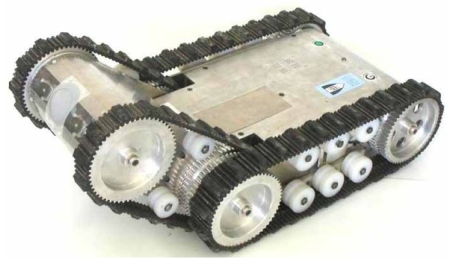RAPOSA robot: Difference between revisions
| Line 28: | Line 28: | ||
=== Permanent staff === | === Permanent staff === | ||
* [http://www.isr.ist.utl.pt/people/yoda Rodrigo Ventura] | * [http://www.isr.ist.utl.pt/people/yoda Rodrigo Ventura] (Assistant Professor) | ||
* [http://users.isr.ist.utl.pt/~pal Pedro Lima] | * [http://users.isr.ist.utl.pt/~pal Pedro Lima] (Associate Professor) | ||
=== Students === | === Students === | ||
* Henrique Martins | * Henrique Martins (MSc student) | ||
* Jorge Ferraz | * Jorge Ferraz (MSc student) | ||
* Nuno Marques | * Nuno Marques (MSc student) | ||
* João Viana | * João Viana (BII scholarship) | ||
=== Alumni === | === Alumni === | ||
* Fausto Ferreira | * Fausto Ferreira (MSc degree) | ||
== Project background == | == Project background == | ||
Revision as of 00:23, 19 June 2009
News and events
- (November 2008) RAPOSA was present in the Forum Ciência Viva where autonomous stair climbing was demonstrated
- (March 2008) RAPOSA was present in the VIII Jornadas de Engenharia Electrotécnica e Computadores.
- (August 2007) A joint team of ISR/IST and IDMind members participated in Civilian European Land-Robot Trial (C-ELROB 2007) event, having achieved the 6th place (in 12 teams) of the Urban Trial.
- (July 2007) RAPOSA was present in the Portugal Electronics and ITs (PorTI 2007) fair, collocated with the Portuguese Presidency of the European Union.
Robot description
RAPOSA is a robot for Search and Rescue (SAR) operations, designed to operate in outdoors hazardous environments, such as debris resulting from structure collapses. At this stage, the robot is equipped for search operations only, defined as the tele-operated detection of victims, using specific sensors, whose information is transmitted to the remote operator. The robot equipment (sensors) may be adapted to the specific needs. At the moment it includes 3 conventional cameras, one thermal camera, several explosive and toxic gas sensors, temperature and humidity sensors, inclinometers, artificial lights, microphone and speakers. The robot dimensions are length: 75cm, width: 37cm, height: 17,5cm and weight: 27Kg.
The robot is semi-autonomous, i.e., it is tele-operated via a wireless link from a remote console using a conventional GUI and a gamepad, but can simultaneously display the capacity to carry out short tasks autonomously. The robot can execute commands sent by a team of SAR experts, located in a safe place. During task execution, the robot is able to process the information from different sensors to the remote command station, so as to provide the human team with relevant information on its surrounding environment (terrain conditions, temperature, dangerous gases, water or heat sources, either from human victims or not). The robot has small dimensions and weight. It is tolerant to impact, dust and humidity and its all terrain capable, namely it can climb stairs. Moreover, it can be lifted by a cable, to facilitate deployment from a height (e.g., into a pipeline).
Research is currently being carried out with the aim of endowing RAPOSA with a higher degree of autonomy, meaning that certain operations requiring manual operation can be done autonomously by the robot. These include: autonomous stair climbing, autonomous docking, and preventive stop after hole detection. Moreover, human-robot interaction issues are also being tackled by improving the operator interface, namely exploring augmented reality techniques.
Videos
Research team
Permanent staff
- Rodrigo Ventura (Assistant Professor)
- Pedro Lima (Associate Professor)
Students
- Henrique Martins (MSc student)
- Jorge Ferraz (MSc student)
- Nuno Marques (MSc student)
- João Viana (BII scholarship)
Alumni
- Fausto Ferreira (MSc degree)
Project background
The RAPOSA robot was developed by a consortium lead by the company IDMind, together with ISR/IST, the Lisbon firefighters brigade, and the University of South California. It was financed by AdI and POSI.
Please check the IDMInd's RAPOSA webpage for further information.
Publications
- Immersive 3-D Teleoperation of a Search and Rescue Robot Using a Head-Mounted Display, Henrique Martins, Rodrigo Ventura, IEEE International Conference on Emerging Techonologies and Factory Automation, accepted for publication, 2009.
- Robust Autonomous Stair Climbing by a Tracked Robot Using Accelerometer Sensors, Jorge Ferraz, Rodrigo Ventura, International Conference on Climbing and Walking Robots (CLAWAR-09), accepted for publication, 2009.
- Autonomous docking of a tracked wheels robot to its tether cable using a vision-based algorithm, Fausto Ferreira, Rodrigo Ventura, Workshop on Robotics for Disaster Response, ICRA 2009 - IEEE International Conference on Robotics and Automation, Kobe, Japan, 2009.
- A Search and Rescue Robot with Tele-Operated Tether Docking System, C. Marques, J. Cristovão, P. Alvito, Pedro Lima, João Frazão, M. Isabel Ribeiro, Rodrigo Ventura, Industrial Robot, Emerald Group Publishing Limited, Vol. 34, No.4, pp. 332-338, 2007 , 2007.
- RAPOSA: Semi-Autonomous Robot for Rescue Operations , C. Marques, J. Cristovão, Pedro Lima, João Frazão, M. Isabel Ribeiro, Rodrigo Ventura, Proc. of IROS2006 - IEEE/RSJ International Conference on Intelligent Robots and Systems, Beijing, China, 2006. — PDF
